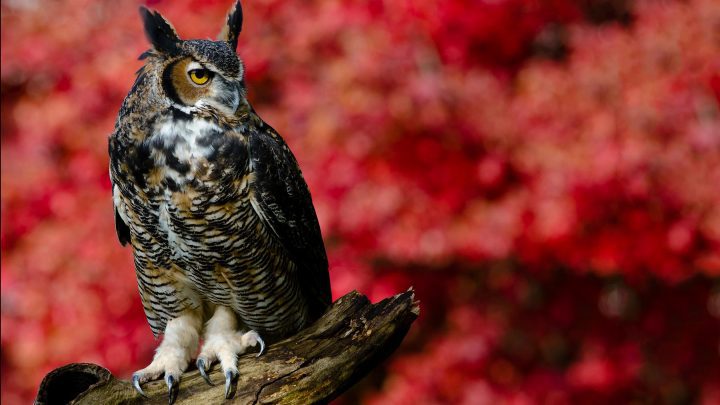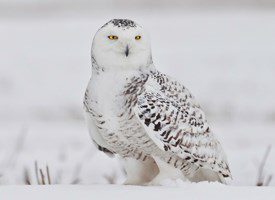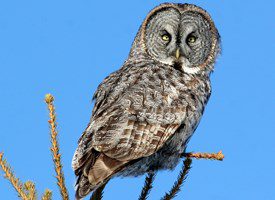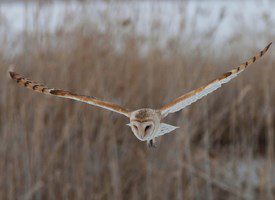Which Is Your Favorite Owl? Here’s a Sampler Platter
April 20, 2008
Owls are an amazingly diverse and interesting family of birds, and they’ve held symbolic roles throughout history. There are 19 owl species in North America. Here are some interesting owl facts about a few of our favorites:
Great Horned Owl
Why we love it: This fierce owl will eat anything.
Great Horned Owls are large owls—about the size of a Red-tailed Hawk. They are very powerful, with large heads and long ear tufts. They are generally warm brown on the upperparts, spotted with darker brown, black and whitish. As with most owls and hawks, the females are larger than the males.
Renowned for their ferocity, Great Horned Owls kill and eat small to medium sized mammals and birds. They are the only animal that regularly eats skunks; they also eat rabbits, mice, rats, squirrels, opossums, groundhogs, bats, weasels, and the occasional cat. They also eat many kinds of birds, from small songbirds up to geese and raptors. In 2012, our Bird Cams project recorded a Great Horned Owl attacking a Great Blue Heron nest in the middle of the night.
In late fall and early winter, the low muffled hooting of a Great Horned Owl may carry great distances, signaling that males are beginning to stake out breeding territories. Males and females sometimes sing duets, with the male giving a rhythmic 4–5 hoots. The female responds with either a higher-pitched 2-syllable call, or 6–8 lower-pitched hoots. Once paired, the male and female may roost together in dense foliage or rock crevices.
Great Horned Owls are very widespread, occupying more habitats than any other owl. Its vast range spans the Canadian boreal forest to the pampas of South America and includes deciduous forests, coniferous forests up to about 11,000 feet, swamps, mangroves, and desert canyons.
In 2014–2015, our Bird Cams project featured a live Great Horned Owl nest cam in Savannah, Georgia.

Snowy Owl
Why we love it: It’s the owl with the most striking appearance.
Standing nearly 2 feet tall and weighing about 4 pounds, the Snowy Owl is North America’s heaviest owl. The plumage of the Snowy Owl is largely white, with variable amounts of brown barring and spots. Adult males tend to be whiter than females—it’s a fun fact that Harry Potter’s all-white, female owl, Hedwig, was played by a male Snowy Owl.
Snowy Owls breed on the open tundra where hummocks, hillocks, or boulders serve as perching and nesting sites. In this frozen landscape, the Snowy Owl’s fate is often tied to the abundance of lemmings. In a good year, a pair of Snowy Owls may raise a dozen nestlings, feeding them some 2,000 lemmings before the young can hunt on their own.
Given the opportunity, Snowy Owls will eat lemmings almost exclusively. Where lemmings are unavailable, Snowy Owls will hunt other small mammals and birds, including rodents, rabbits, squirrels, songbirds, waterfowl, wading birds, and alcids such as murrelets.
The breeding range of the Snowy Owl is circumpolar, ranging across the northern regions of Greenland, Scandinavia, Russia, Alaska, and Canada. In North America, winter irruptions bring Snowy Owls into southern Canada about once every four years, and occasionally they appear well south into the United States.
In 2014, our Bird Cams project featured a live Snowy Owl nest cam from Barrow, Alaska.

Great Gray Owl
Why we love it: At up to 32 inches tall, it’s the largest owl in North America.
Great Gray Owls have large heads in the shape of a half dome, with several narrow concentric rings of white and gray around each yellow eye, and a neat white “bow tie” marking at the neck. The scientific name “nebulosa” means “cloudy” and refers to the bird’s gray tones.
Great Gray Owls have a talent for detecting and seizing prey under thick layers of snow and ice. They can hear voles and pocket gophers moving underneath the snow and plunge through the snow surface to grab their quarry.
During courtship, male Great Gray Owls issue deep, booming hoots with a muffled quality. For nesting, Great Gray Owls use abandoned structures built by ravens or hawks. Females lay from two to five eggs (usually three). The female incubates the eggs and broods the hatchlings, while the male hunts and brings food to the female and young until fledging.
Great Gray Owls inhabit boreal forests in Canada, northern Europe, and Siberia. Their North American range also includes limited areas of forest in the Cascades, Sierra Nevada, Rocky Mountains, and smaller ranges in the mountain states. Great Gray Owls prefer forest habitat adjacent to open meadows, bogs, or muskeg.
Barred Owl
Why we love it: This is the owl with the greatest call.
In this video, Laura Erickson describes the nocturnal ruckus that can accompany an amorous pair of Barred Owls—beginning with odd screeching and ending with this owl’s unmistakeable “who-cooks-for-you” call.
This attractive owl, with soulful brown eyes and brown-and-white-striped plumage, can also pass completely unnoticed as it flies noiselessly through the dense canopy or snoozes on a tree limb. Originally a bird of the east, during the twentieth century it spread through the Pacific Northwest and southward into California.
Barred Owls eat mostly small mammals such as chipmunks and voles, although they also eat birds up to the size of grouse. Woodpeckers, crows, and small songbirds recognize Barred Owls as threats and may gather around them in a noisy mob to drive them away. This owl’s most dangerous predator is another owl: the Great Horned.
During nesting season, check out our Bird Cams project’s live Barred Owl nest cam.

Barn Owl
Why we love it: An almost human-looking owl with a heart-shaped face.
Barn Owls are perhaps the most widespread of all land birds, found on every continent except Antarctica and on many island groups. Barn Owls have a distinctive white, heart-shaped face and dark brown eyes. Their plumage is warm brown, elegantly flecked with dots of darker brown. Males are usually paler and slightly smaller than females.
In a family renowned for its sensitive hearing, the Barn Owl is perhaps the top performer. Experiments have shown that they can locate and catch prey in absolute darkness. They hunt at night in open country, flying low with soft, buoyant wingbeats over marshes, grasslands, and fields. During the course of a night they may fly for miles, sometimes following regular hunting routes along fence lines, hedgerows, and woodland edges. They eat mainly rodents, especially voles, but also shrews, ground squirrels, rabbits, lizards, and other animals.
By day, Barn Owls roost in hollow trees, crevices in cliffs, and in buildings such as barns, abandoned buildings, and church towers. They will nest in nest boxes if they are available. Barn Owls do not hoot as is typical of many owls; rather, they issue a hissing shriek.
During nesting season, check out our Bird Cams project’s live Barn Owl nest cam.
Haven’t found your owl yet?
Keep looking for your favorite owl by visiting these species profiles in our All About Birds guide:

All About Birds
is a free resource
Available for everyone,
funded by donors like you
American Kestrel by Blair Dudeck / Macaulay Library
